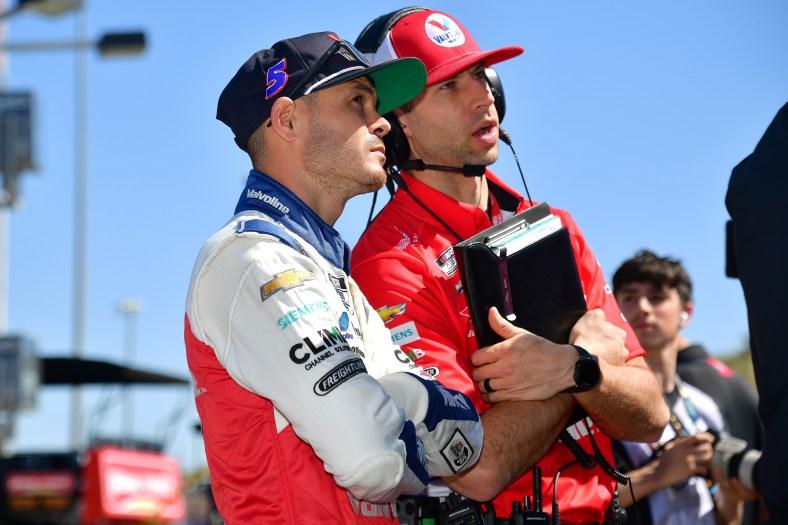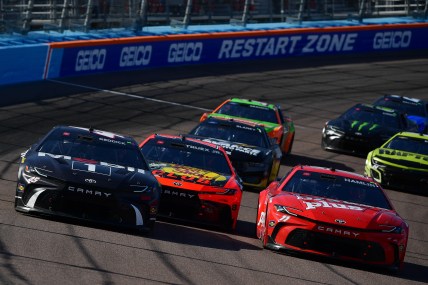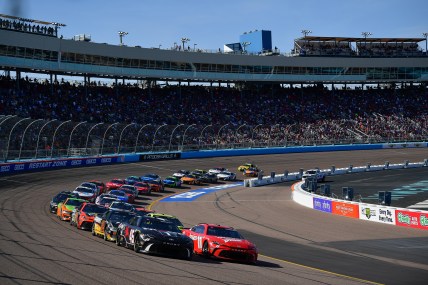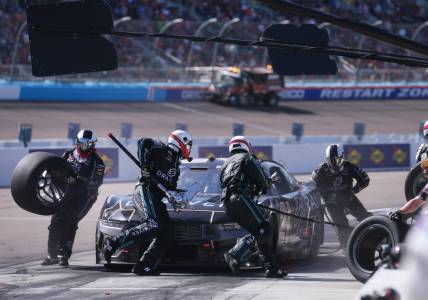
Kyle Larson is the latest Cup Series driver to advocate for a horsepower increase, at least on short tracks and road courses, while also pushing back against the NASCAR official argument that it would increase engine budgets.
This comes a day after Denny Hamlin made a similar push.
Appearing on Dale Earnhardt Jr.’s podcast on Tuesday, The Dale Jr Download, Larson echoed a sentiment expressed by the likes of Denny Hamlin and Brad Keselowski over the weekend that the new short track package did result in a marginal decrease in dirty air.
In other words, it helps passing a little bit on Sunday at Phoenix, even if that track isn’t the best judge of what the industry is trying to accomplish.
“I thought it was just a little bit better,” Larson told Earnhardt. “And, like you said, Phoenix is Phoenix and as long as I’ve been going there, it’s been very hard to pass and the race has been fairly similar to what we had on Sunday.
“But now, with the NextGen, everyone’s car is so equal so it’s harder to move forward. I thought you could manipulate the guy in front of you a bit more. I thought, maybe my car was a touch better than before, but I thought I could create angles on entry more to try and set up a position on someone. Yes, it was slightly better but for Phoenix, I don’t know what you can do to get it to look amazing. It is what it is and I guess we’ll see what it is on Martinsville. We’ll see.”
Larson also said the new tire compound for Phoenix only made a marginal improvement over November too.
But then the conversation turned to horsepower, and Larson detailed all the reasons it would make the racing better on tracks like Richmond, Phoenix, Martinsville, North Wilkesboro and New Hampshire.
“Your difference in top speed to minimum speed would be much greater,” Larson said. “I think that would allow you to create different styles of how to get around the corner. It would just allow for drivers to make more mistakes entering the corner much faster or not necessarily faster but having to lift much sooner. It would make the braking zones longer, which helps.
“I think, when you have that power, you can use different lines to accelerate. I hope someday in my career that they can at least try it. Take us to somewhere, Richmond, somewhere and go test. Go test at Martinsville. Try it out.”
NASCAR Cup Series managing director Brad Moran appeared on SiriusXM NASCAR Radio on Tuesday morning and made the argument, once again, that the reluctance to a horsepower increase came down to cost and new manufacturers.
Larson doesn’t accept that either and cited his own organizational engine department.
“They’ve always used the excuse, ‘well we’re trying to keep power to where other manufacturers will come in’ but as long as I’ve been in the sport, 10 years, it’s been the same three manufacturers.
“So, maybe someone else is coming and they’re the ones pushing for lower horsepower but I’ve yet to see someone new come in and all these engine builders and teams keep saying it’s not going to cost any different to do it. I’ve heard (Hendrick Motorsports powertrain director) Scott Maxim say we could bring 1000 horsepower next week and it wouldn’t cost more.”
The current generation engine can makes almost 1000 horses but they are tapered down using a plate that currently limits output to 670.
“They are literally taking the engine I won with at Las Vegas, a 1000 horsepower engine, and then putting it in one of Rick’s personal cars, so they can do it,” Larson said.
The only other reluctance is that Tyler Reddick doesn’t think even 750 would work. It would probably have to be completely unrestricted to start making a dent, due to how draggy and heavy the NextGen.
Matt Weaver is a Motorsports Insider for Sportsnaut. Follow him on Twitter.


